Food Preservation Methods - Preservation by High Osmotic Pressure | 11th Home Science : Chapter 4 : Food Preservation Methods
Chapter: 11th Home Science : Chapter 4 : Food Preservation Methods
Preservation by High Osmotic Pressure
Preservation by High Osmotic Pressure
The principle of osmosis is used to pre-serve
jams, jellies and pickles. In this process, water tends to draw out from
microbes (plasmolysis) and makes it dehy-drated, thus killing them.
But yeasts and moulds are relatively resistant to high osmotic pressure. Hence,
preserved foods like pickles tend to spoil if not stored properly.
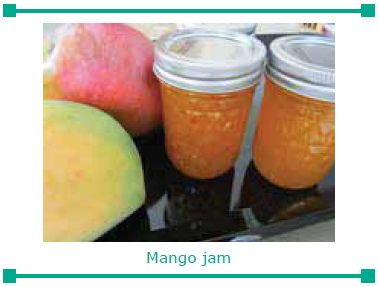
1. High Concentration of Sugar
Sugar is used to preserve fruits. Preserving
fruits in honey to avoid spoilage is a well known practice. Nowadays jams and
jellies prepared from fruits have a high concen-tration of sugar and it acts as
a preserva-tive. Pectin, acid and sugar are essential to prepare jam. Jam or
jelly are prepared by adding commercially prepared pectin and it also reduces
the cooking time. Jellies are clear substances made of fruit juice or the
extract of a fruit.
Sugar acts in the following ways:
·
Sugar draws the water out of food therefore making it
unavailable for microorganisms.
·
As a result of water loss, microbial metabolism is stopped.
·
Hence, the growth of microorganisms is stopped
Preparation of jelly:
·
Under-ripe fruits are used, because the pectin content is high
and good acidity is essential for a good jelly.
·
Pieces of fruit are completely immersed in water and cooked for
10–20 min-utes. Hard fruits like guavas need to be cooked for 45 minutes.
·
After the fruit is cooked, it is strained without disturbing the
fruit pieces.
·
The fruit extracts contain pectin which determines the addition
of sugar. When the level of pectin is high, it needs more sugar but requires
less boiling time.
·
Rapid boiling facilitates rapid evapora-tion, which avoids
strong flavour and darkened colour.
·
Then the jelly is poured in bottles or moulds, and allowed to
set without any disturbance.
Preparation of jam:
·
Fruits like apples are cooked with skin and made into pulp with
the strainer for making jam
·
Equal quantities of sugar and pulp are taken to make jam.
·
After it is cooked, it is transferred to a sterilized bottle and
allowed to cool.
Test for doneness for jam
Sheet test – the mixture is allowed to drip
from a large cool spoon. If the syrup forms a sheet instead of two separate
drops, the jam is done.
Bubble test – when the end point reaches, big
bubbles can be seen throughout the jam.
Plate test – set a plate in the freezer for
some time. Put the jam and tilt the plate slowly. The jam should come down as a
whole mass forming “U” shape. Water should not separate out.
Fork test – dip the fork into the jam or
jelly. Jam of correct consistency forms a sheet between the needles of the
fork.
Honey
Honey is a natural preservative in its
orig-inal state and was one of the earliest pre-servatives used by ancient
civilizations. It has a high concentration of sugar that draws out the water
out of yeast or bacte-ria cells which contaminate the food.
2. High Concentration of Salt
Foods are also preserved by the principle of
osmotic pressure in salting and pick-ling. Most commonly used preservative is
sodium chloride. Required quantity may be added to slow down or prevent the
growth of microorganisms or enough to permit lactic acid fermentation to take
place.
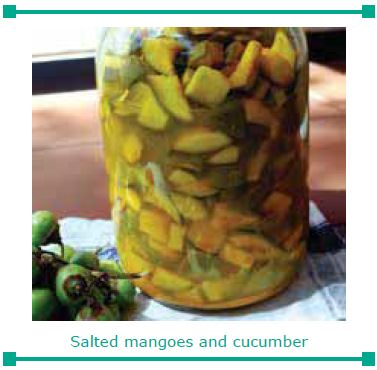
Sodium chloride preserves the food by the
following principles:
·
It causes the high osmotic pressure and hence plasmolysis
occurs.
·
It dehydrates foods by drawing out and tying up moisture, as it
dehydrates microbial cell.
• It ionizes to yield the chlorine ion which
is harmful to organisms.
·
It reduces the solubility of oxygen in the moisture.
·
It sensitizes the cell against carbon dioxide.
·
It interferes with the action of pro-teolytic enzymes.
Pickling:
In pickling, food is placed in edible liq-uids
like brine, vinegar or vegetable oil which inhibit or kill microorganisms.
Sometimes, food is heated along with pickling
agent so that it gets saturated with it.
Pickles may be broadly divided into three groups:
Sweet pickles e.g., tomato sweet pickle, mango
sweet pickle.
Sour pickles e.g., mango pickle, lime pickle.
Fermented pickles e.g., cucumber pick-le,
cabbage pickle, chilli pickle, meat and sausages.
The important preservative agents in pickles
are salt, vinegar, sugar, oil, spices and condiments. Each has a specific role
in preservation.
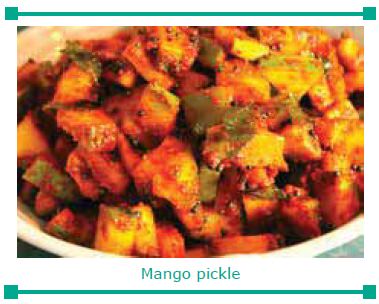
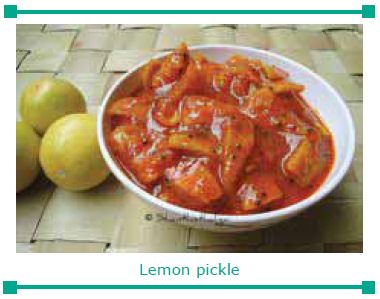
Salt:
Salt is employed to control microbial
pop-ulation in foods such as butter, cheese, cabbage, olives, cucumbers, meats,
fish and bread. There are four methods of salt curing; dry salting (fish),
brimming (vadu manga), low salt fermentation (chilli pickle, sauerkraut from
cabbage) and pickling (lime pickle). Sodium chlo-ride or common salt is used
primarily as a preservative and flavouring agent.
Vinegar:
Vinegar is a natural preservative. Vinegar is
made from a two step process. The first process involves the carbohydrate being
converted into alcohol by fermentation. The second step is its conversion to an
acetic acid. The acetic acid in vinegar kills microbes and stops food spoilage.
Pickling is a common method of using vinegar as a preservative. It is also used
to improve the flavour of foods.
Spices and condiments:
These have bacteriostatic effect (slowing the
growth and multiplication of microbes). The essential oil of spices is
inhibitor of microorganism. The inhibitory effects of the spices differ with
the kind of spice and the microorganisms being tested. Mustard flour and the
volatile oil of mus-tard, for example, are very effective against Saccharomyces cerevisiae. In pickles like avakai and chilli pickle,
mustard flour helps in the prevention of the growth of spoilage organisms in
the food.
Turmeric powder, tamarind, chilli powder,
asafoetida, fenugreek seed, cin-namon and cloves are usually bacterio-static. Ground pepper corn and all spices are less inhibitory than cinnamon and cloves. Extracts of these
plants have been shown to be inhibitory to Bacillus subtilis and E. coli. Allicin is the active principle in onions and garlic that
kills bacteria and acts against fungi.
Oil:
In addition to salt and several spices, oils
are used in making pickles. Spice mixtures and oil are added to the fruit or
vegetable. It is allowed to ferment for a month or so. The fermentation process
renders fruits soft and the fruit take on the additional aroma and flavour of
the spices. Aerobic bacteria and mould growth are prevented by covering the top
with oil. Properly pre-pared and stored pickles can last upto a year or more
without spoilage.
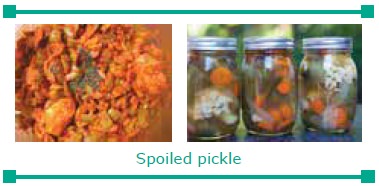
Related Topics